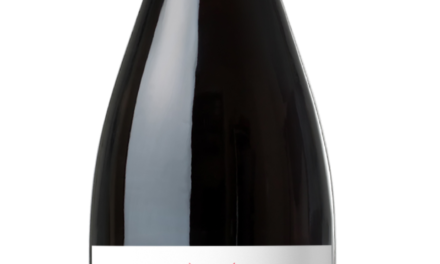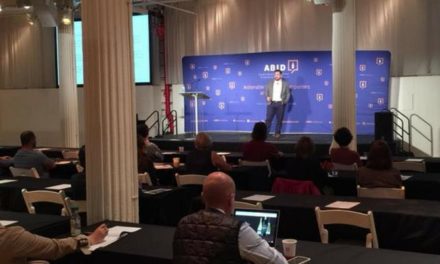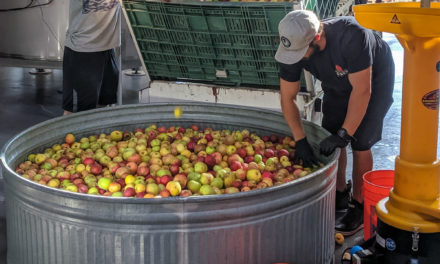For those squeamish about the idea of machine-picked winegrapes, I have one question: How do you think a bottle of wine can cost less than $20? The truth is, most of the wine in stores is already made from mechanically harvested grapes.
The good news is, today’s harvesters beat the pants off older models that damaged vines and delivered bins full of mush and MOG (material other than grapes). Popular harvesters hail from Braud (New Holland, USA), Gregoire (Australia), Oxbo (USA), and Pellenc (France); they work by shaking vines, as gently as possible, to release fruit. The newest versions have onboard optical sorters that deliver ultraclean fruit ready to plop into a fermenter.
Mechanical harvesters can process up to two acres per hour, whereas it can take 20 to 30 skilled laborers an hour to do a single acre—at two or three times the cost per ton. Machines can sort fruit right in the field, eliminating additional labor and cleanup in the winery, and picking can be done at night without having to set up expensive lighting systems. Fruit can be picked and delivered cold, directly to fermenters, without sitting in picking bins, which increases the risk of spoilage and oxidation. Although steep terrain and older head trained vines (along with some Lyre/Geneva trellis systems) rule out mechanical, most trellised vineyards can be mechanically harvested.
Advantage: Machine

Jason Smith, Paraiso Vineyards [Photo courtesy Smith Family Vineyards]
Jason Smith of Paraiso Vineyards farms 3,200 vineyard acres in California’s Salinas Valley using every mechanical trick he can find, because it helps him keep costs down in the ultra competitive on-premise market. “My gut feel is that more than 90 percent of all winegrapes in California are machine-picked,” he says.
Dave Michul, who’s been general manager at Beckstoffer Vineyards for 18 years, says, “The majority of our vineyards in Lake and Mendocino counties are machine picked.” Getting Napa winemakers to opt for machine harvesting in their storied location, though, is proving trickier, so he’s working on trials to show that improved technology in harvesting equipment is good and, “we’re conducting trials to prove the quality is deliverable.”
Been there and done that, says Hahn winemaker Paul Clifton. “We’ve run many trials comparing [Pellenc] Selectiv Process harvesting and hand harvesting. Tasting blind, it’s difficult for us to say there’s a large benefit to hand harvesting over mechanical—but I still refuse to give up on hand harvesting completely.
“That said, if it came down to not getting leafing or harvesting finished on time due to a lack of labor, jeopardizing quality, or turning to mechanization to make sure it gets done when it should, I have no problem putting a Pellenc in the vineyard.”
Math Favors Purchase
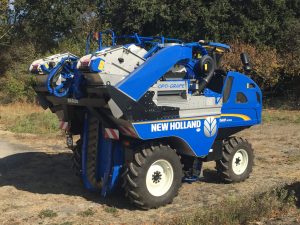
Foley Family Wines in California has invested in harvesters from Braud (New Holland) and Gregorie. [Photo courtesy Foley Family Wines]
He continues, “We machine harvest many different varietals for several of our wineries, including Sebastiani, Langtry Estate, Guenoc, Firestone, Foley Estates, Chalone, and Foley-Sonoma.
“We’ve been hiring out harvesting services for many years. This past year, we rented two machines for the season and, moving forward, it makes more sense to purchase our own machines. We’re now leasing-to-buy two Brauds (new Holland) and one Gregorie. ROI is about four years. In light of ongoing labor shortages we’ve experienced, we must have sold control of our harvest decisions and not be held up when the fruit is ready to come in. We’ve been converting many of our trellis systems over to be compatible with mechanical harvesting—and all our new vineyards installations will also be compatible.”
According to winemaker Chris Brundrett of William Chris Vineyards, Texas viticulture embraced mechanical harvesting from the start. He believes about 90 percent of Texas vineyards are mechanically harvested. He uses the G3, G6, and G8 Gregoire harvester models and Pellencs with optical sorting, calling them “a game changer in our industry. We can make great wines with fabulous, machine-harvested fruit—as long as we have good farming practices and operator training!”
Paul Buwalda, vineyard manager at Concannon in Livermore, Calif., grew up on a dairy farm in the Midwest, so he’s very familiar with mechanical harvesting.
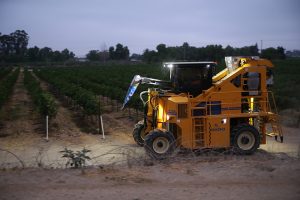
Concannon Vineyards leased an Oxbo mechanical harvester with an onboard de-stemmer and berry cleaning system, which can be connected to and tracked remotely using cell and GPS technology.
“This gives us options at harvest time and reduces down time in the field,” says Buwalda. “Technology is proving invaluable. It will be the reason many wineries can remain financially sustainable. This harvester is a great example of the use of new technologies in the field.”
Kathryn Van Weerdhuizen of Oxbo International Corp. says its PremiumSort onboard destemming and sorting system has proven extremely popular. The company’s unique bucket conveyance system delivers more whole fruit and juice, and the three-fan cleaning system is highly effective at removing MOG.
“Like all businesses, the wine industry experiences business cycles,” she says. “Over the past five years we’ve seen demand [for our machines] increase as vineyards continue to mechanize and reduce the number of laborers at harvest time. Some of this growth has been driven by onboard cleaning technology.”
Cleaner Fruit

Matt Parish, Lula Cellars [Photo courtesy Lula Cellars]
“I’ve harvested luxury Pinot Noir mechanically and with the new picking and sorting technologies, the quality outcome was so impressive, I actually preferred it to hand-picked fruit.” He notes that many countries, including Australia and New Zealand, are already highly mechanized due to their inherent lack of labor or high labor costs.
Paraiso’s Smith says, “The start of mechanization began in coastal vineyards in the mid-’90s with vertical trellising. Our Pinot Noir is all machine harvested: it’s de-stemmed onboard and comes in cleaner than if picked by hand.”
Pellenc America Sales Rep John Felice has been selling Pellenc and other vineyard equipment for more than 10 years and has never seen such strong interest in mechanical harvesting. Winemakers doing mechanical versus handpicking experiments are finding that blind tests heavily favor mechanical. He’s seeing a steady adaption of mechanical harvesting, even in the reluctant areas such as Sonoma and Napa counties.
“Acceptance is building,” he says. “More winemakers are asking for trials.” Some of the larger vineyards in Sonoma are now moving towards 50 percent mechanical, if not more.
“The bigger issue is that wineries are very particular about when they want to pick. Labor is such a factor. There’s a lot of coordination that occurs and mechanical harvesting helps bring stability. The mechanical harvester is not going to renegotiate a contract.”
Accepting the inevitable
Bill Brosseau of Testarossa Winery in Los Gatos, Calif., prefers not to use mechanical harvesting at this time but admits it’s likely the way of the future, as recent technological advances and low availability of quality labor are accelerating this tipping point. “Growers are still trying to raise prices, but pretty soon, I have a feeling wineries won’t be able to pay more, given the pricing squeeze going on in the restaurant and retail marketplace,” he says. “With the increasing labor cost and shortage, mechanization will continue to be more enticing.”
Smith summarizes it well: “The grape industry is very progressive. Mechanization is high on the list in all of California agriculture. Farmers are resilient. We’re always looking for ways to do things better—and, at the same time, to stay in business!”



